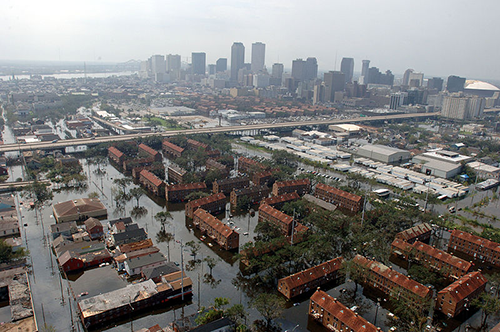Aug 31 2015 Cross-sector collaboration has provided New Orleans with a path toward recovery
 This past Saturday marked 10 years since Hurricane Katrina hit the Gulf Coast, the costliest disaster in United States history. The storm that struck on August 29, 2005, destroyed infrastructure and displaced people at an unprecedented scale, leaving the city of New Orleans struggling in its wake. As Mayor of New Orleans Mitch Landrieu explained in a recent Quartz article, “not even the wealthiest philanthropist or most efficient government institution could single-handedly save us from the rubble.” And while the city is still in some ways struggling to regain its footing even a decade later, collaboration across government, non-profit, and business sectors has provided one path toward recovery and toward rebuilding the city even stronger than it was before the storm.
This past Saturday marked 10 years since Hurricane Katrina hit the Gulf Coast, the costliest disaster in United States history. The storm that struck on August 29, 2005, destroyed infrastructure and displaced people at an unprecedented scale, leaving the city of New Orleans struggling in its wake. As Mayor of New Orleans Mitch Landrieu explained in a recent Quartz article, “not even the wealthiest philanthropist or most efficient government institution could single-handedly save us from the rubble.” And while the city is still in some ways struggling to regain its footing even a decade later, collaboration across government, non-profit, and business sectors has provided one path toward recovery and toward rebuilding the city even stronger than it was before the storm.
Cross-sector collaboration, with its emphasis on “pooling brainpower and resources through partnerships … was the new way of doing things our nearly 300-year old city desperately needed,” wrote Mayor Landrieu. One intersector project that we profile in our Case Library shows the value of working together in this way. After St. Bernard’s Housing Community (SBHC), the largest public housing development in New Orleans, was destroyed during Katrina, the Bayou District Foundation was formed to revitalize the development. The Foundation worked closely with government agencies (like the Housing Authority of New Orleans, which provided funding and oversaw the redevelopment process), businesses (Columbia Residential, which constructed the 685 mixed-income housing units), and non-profit partners (including the Fore!Kids Foundation and Kingsley House, who helped provide programming and support to residents) to revitalize the development.
The collaborations that came about post-Katrina were crucial in helping New Orleans recover. But even more importantly, they provided the opportunity to, as Mayor Landrieu explains, “create the New Orleans that always should have been.” This is true of the Bayou District Foundation: Prior to the storm, SBHC was plagued with overcrowding, failing schools, and violent crime, but the Foundation addressed these issues as they rebuilt the development, resulting in a 99.7 percent reduction in felonies over four years and the creation of tuition-free education facilities.
“New Orleans leaders and citizens alike … recognized that the rebuilt city needed to be fairer, and healthier, than what came before,” wrote Risa Lavizzo-Mourey, CEO of the Robert Wood Johnson Foundation, in a blog post that details the public-health related collaborations that came about after the storm. She walks through the collaboration that rebuilt the Circle Food Store in the Treme neighborhood of New Orleans, noting that it was a long, difficult task, but that it ultimately came back even better than before, with a new pharmacy, more produce, and healthier products.
The future of the city will depend on continued and new collaboration, which is no more apparent than in the city’s new resilience plan, released by cross-sector partners last week. As part of the Rockefeller Foundation’s 100 Resilient Cities, the City will be connected with public and private partners and provided with the funds to hire a Chief Resilience Officer, to ensure it is prepared to address disasters in the future. “New Orleans is a story of collaboration,” wrote Mayor Landrieu, and with strong partnerships continuing to develop, it’s a story that will strengthen and grow in the years to come.
